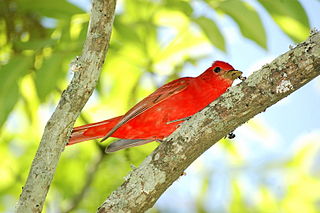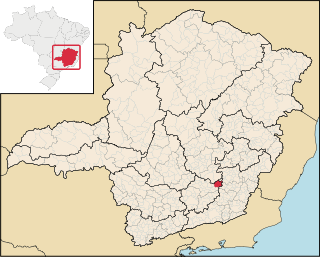Related Research Articles

The scarlet tanager is a medium-sized American songbird. Until recently, it was placed in the tanager family (Thraupidae), but it and other members of its genus are now classified as belonging to the cardinal family (Cardinalidae). The species' plumage and vocalizations are similar to other members of the cardinal family, although the Piranga species lacks the thick conical bill that many cardinals possess. The species resides in thick deciduous woodlands and suburbs.

The summer tanager is a medium-sized American songbird. Formerly placed in the tanager family (Thraupidae), it and other members of its genus are now classified in the cardinal family (Cardinalidae). The species's plumage and vocalizations are similar to other members of the cardinal family.

Diadema is a municipality in São Paulo state, Brazil. Belonging to the ABCD Region of Greater São Paulo, it is 17 km (11 mi) distant from São Paulo's central point. Initially part of São Bernardo do Campo, Diadema became a city of its own in 1959. The population is 426,757 in an area of 30.76 km2 (11.88 sq mi). The annual mean temperature in the city is 19.6 °C (67.3 °F). Its HDI is 0.790.

São Paulo dos Campos de Piratininga was the village that developed as São Paulo, Brazil in the region known as Campos de Piratininga. It was founded as a religious mission and a Jesuit Royal College by priests José de Anchieta and Manuel da Nóbrega on January 25, 1554. The village was initially populated by Portuguese colonists and two tribes of the Guaianás Amerindians. Later, São Paulo was the base of the Bandeiras, which was the great colonial expansion of the 17th century into the interior of the territory.

Itapecerica da Serra is a municipality in the state of São Paulo in Brazil. It is part of the Metropolitan Region of São Paulo. The population is 177,662 in an area of 150.74 km². It is located 23 miles southwest of São Paulo and at an altitude of 920m above sea level. The name Itapecerica is believed to come from the Tupi language for slippery stone, and da Serra means of the Mountains in Portuguese.

Piratininga is a municipality (município) in the state of São Paulo (state) in Brazil. The population is 13,765 in an area of 402 km².

The flame-colored tanager, formerly known as the stripe-backed tanager, is a medium-sized American songbird in the family Cardinalidae, the cardinals or cardinal grosbeaks. It is found from Mexico throughout Central America to northern Panama and occasionally in the United States; four subspecies are recognized. The flame-colored tanager is 18 to 19 cm long, the male having predominantly red-orange while the female is more yellowish orange.

Piranga is a genus of birds long placed in the tanager family, but now considered members of the cardinal family, Cardinalidae. The genus name Piranga is from Tupi word tijepiranga, the name for an unknown small bird.

The hepatic tanager is a medium-sized American songbird. Formerly placed in the tanager family (Thraupidae), it and other members of the genus Piranga are now classified in the cardinal family (Cardinalidae). The species's plumage and vocalizations are similar to other members of the cardinal family.

Jorge Tibiriçá Piratininga was a freemason, and the seventh "president" of the State of São Paulo (Brazil) and its second governor.

The red-headed tanager is a medium-sized American songbird in the family Cardinalidae, the cardinals or cardinal grosbeaks. It is endemic to Mexico. The red-headed tanager is around 15 cm (5.9 in) long, the male has predominantly yellow-olive plumage with a red head and throat, while the female has a yellowish forecrown.

The white-winged tanager is a medium-sized American songbird in the family Cardinalidae, the cardinals or cardinal grosbeaks. It is found from Mexico, through Central America, across northern South America and as far south as Bolivia.

The rose-throated tanager is a medium-sized songbird in the family Cardinalidae, the cardinals or cardinal grosbeaks. Endemic to the Yucatán Peninsula in Central America, it is found in Belize, Guatemala, and Mexico. The male has greyish plumage with a deep rose throat and crown, while the female is similar but for a yellow crown and throat.

The red-hooded tanager, is a medium-sized American songbird in the family Cardinalidae, the cardinals or cardinal grosbeaks. It is found in Colombia, Ecuador, and Peru.

Piranga is a Brazilian municipality located in the state of Minas Gerais. The city belongs to the mesoregion of Zona da Mata and to the microregion of Viçosa. As of 2020, the estimated population was 17,634.

Cryptanthus pickelii is a plant species in the genus Cryptanthus. This species is endemic to Brazil.

Hemilophini is a tribe of longhorn beetles of the subfamily Lamiinae.
Piratininga is a genus of longhorn beetles of the subfamily Lamiinae, containing the following species:

The Pennsylvania State Game Lands Number 148 are Pennsylvania State Game Lands in Beaver County in Pennsylvania in the United States providing hunting, hiking, bird watching, wildlife photography and other activities.
References
- ↑ BioLib.cz - Piratininga piranga. Retrieved on 8 September 2014.